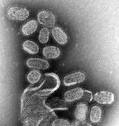New flu may not spread like regular flu
Rueters
By Maggie Fox, Health and Science Editor
 WASHINGTON (Reuters) – The new H1N1 influenza strain may be just a little less catching than seasonal flu, but seems a little better able to cause stomach upsets, researchers reported on Thursday.
WASHINGTON (Reuters) – The new H1N1 influenza strain may be just a little less catching than seasonal flu, but seems a little better able to cause stomach upsets, researchers reported on Thursday.
Genetic analysis and lab experiments with the virus show it lacks a piece of genetic material that makes ordinary flu viruses so transmissible, a team of U.S. researchers found.
Researchers in the Netherlands, meanwhile, found it lives very well in the nose and their findings suggest it has the ability to stay around for a long time — and get worse.
Both studies, published in the journal Science, show that H1N1 swine flu needs to be closely watched, said Dr. Terrence Tumpey of the U.S. Centers for Disease Control and Prevention.
“I think the take-home message is that we really need to keep a close eye on this virus,” Tumpey said in a telephone interview.
Last month the World Health Organization declared a pandemic of the new swine flu. It has been confirmed in more than 77,000 people globally and has killed at least 332 people, but U.S. officials have said there are likely a million or more cases in the United States alone.
Although flu season usually ends in April in the Northern Hemisphere, the new virus is still causing widespread illness and it is actively in the mix of seasonal flu viruses now circulating during the Southern Hemisphere’s winter.
Tumpey and colleagues tested samples of the new virus from a California child who recovered from a mild bout with the new flu, a Texas child who died and a Mexican woman who had severe disease.
They compared it to ordinary, seasonal H1N1 flu, testing it in ferrets, which develop flu in ways similar to humans.
The ferrets did not catch the new swine flu from one another as easily as they catch ordinary viruses, Tumpey said. Usually, if a ferret is infected with human flu, it infects all other ferrets in nearby cages. But with the new H1N1, only six out of nine animals became infected.
HOUSEHOLD SPREAD
Usually 20 percent to 30 percent of household members are infected by a single flu patient but H1N1 swine flu may have a lower transmission rate, Tumpey said.
In addition, all previous pandemic flu strains — from 1918, 1957 and 1968 — have had a specific genetic sequence in a gene called PB2. The new H1N1 does not have this particular mutation, Tumpey said.
He said health officials should keep an eye out for it, as the change may signal the virus is gaining the ability to spread more quickly and easily than it already does. Researchers are also watching for signs the virus has developed mutations that allow it to resist antiviral drugs — and have found two instances so far, one in Japan and one in Denmark.
In addition, Tumpey’s team found mutations that let the new H1N1 virus live in the small intestine — something seasonal influenza cannot do. This may explain why so many swine flu patients have stomach upsets such as nausea and diarrhea, the researchers said.
In the other report, Ron Fouchier and colleagues at Erasmus Medical Center in Rotterdam found the virus lived well in ferrets and spread very easily from one to another.
In fact, ferrets shed more virus with new H1N1 than with seasonal flu — meaning more of it came out of their noses, Fouchier’s team found.
Ferrets inoculated with the new swine flu virus were a little sicker and took a little longer to recover than ferrets infected with seasonal H1N1.
“These data suggest that the 2009A(H1N1) influenza virus has the ability to persist in the human population, potentially with more severe clinical consequences,” they wrote.
(Editing by Mohammad Zargham)
Preliminary study findings suggest Mexicans may be genetically susceptible to the H1N1 virus
World Health News
 In a landmark study conducted by Mexico’s National Institute of Genomic Medicine (INMEGEN), researchers examined the genetic composition of 300 Mexican Mestizos – people of mixed European and Amerindian ancestry who represent more than 80 percent of Mexico’s population – from six geographically distant states in Mexico. They also looked at 30 members of Amerindian descent from the indigenous Zapotecas group in the state of Oaxaca. As they discovered, the genetic make-up of these two populations is significantly different from three other known human genetic subgroups documented through the historic International HapMap Project.
In a landmark study conducted by Mexico’s National Institute of Genomic Medicine (INMEGEN), researchers examined the genetic composition of 300 Mexican Mestizos – people of mixed European and Amerindian ancestry who represent more than 80 percent of Mexico’s population – from six geographically distant states in Mexico. They also looked at 30 members of Amerindian descent from the indigenous Zapotecas group in the state of Oaxaca. As they discovered, the genetic make-up of these two populations is significantly different from three other known human genetic subgroups documented through the historic International HapMap Project.
The goal of the research was to determine the “comparability of Latino genomes to others in the global search for health-related genes throughout humanity.” While their findings are preliminary, the results of the study may one day help explain why the H1N1 flu was deadlier in Mexico. Says Dr. Gerardo Jimenez-Sanchez of INMEGEN, who led the research team, “It is not possible today to say genetic variation is responsible for the unique H1N1 Influenza A mortality rate in Mexico. However, knowledge of genomic variability in the Mexican population can allow the identification of genetic variations that confer susceptibility to common diseases, including infections such as the flu.” And he adds, “It will also help develop pharmacogenomics to help produce medicines tailored to people of a specific genetic group, to the creation of drugs that are both safer and more effective.”
INMEGEN was established in 2004 under then-Health Minister Dr. Julio Frenk, who is currently the Dean of the School of Public Health at Harvard University. As Dr. Frenk notes, “This study makes clear that Latin Americans with mixed ancestry are different enough from other people worldwide that a full-scale genomic mapping project would be wise both scientifically and economically. It would allow doctors to analyze fewer genetic markers when diagnosing the risk that a patient will develop a disease that depends on complex factors.” The findings were recently published in the Proceedings of the National Academy of Science.
News Release: Landmark study reveals significant genetic variation between Mexico’s population and world’s other known genetic subgroups www.sciencedaily.com May 12, 2009










leave a comment